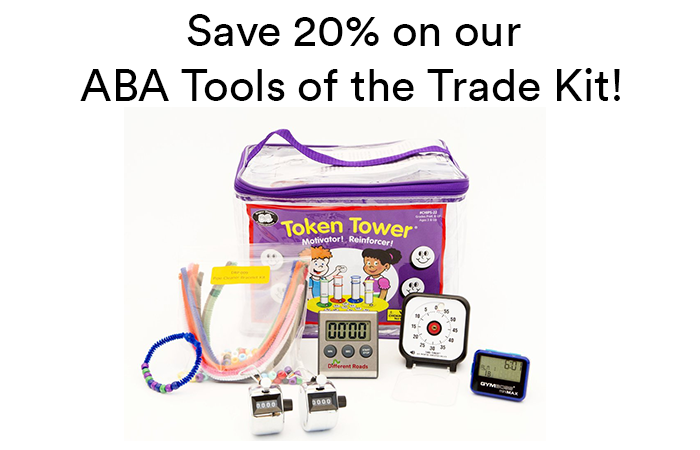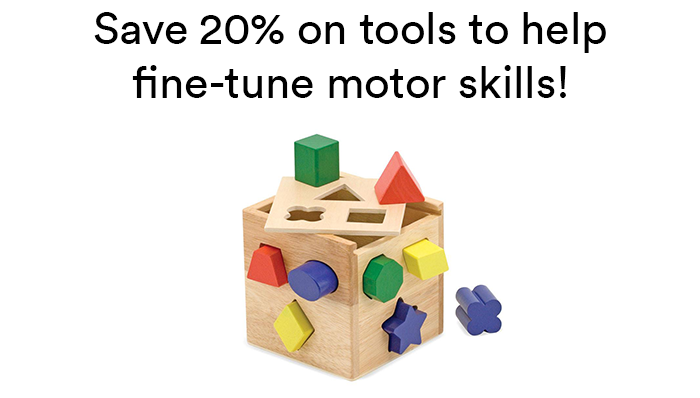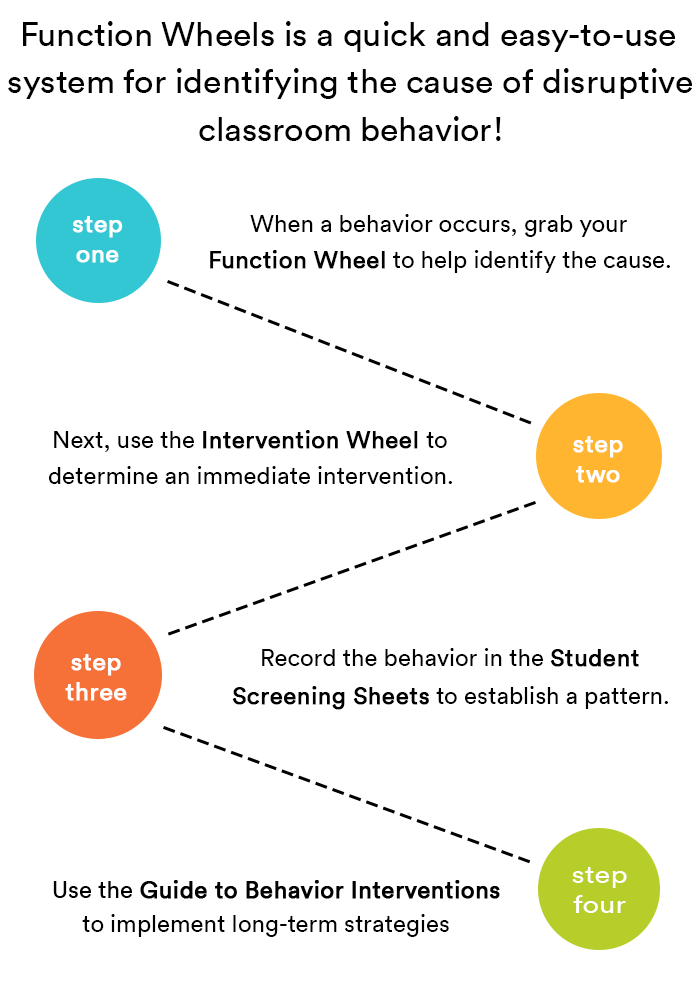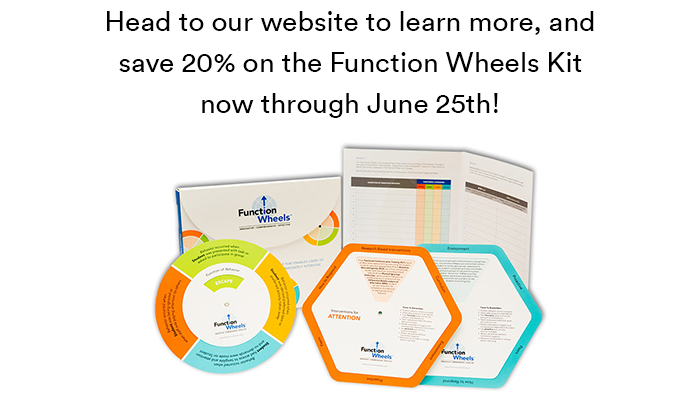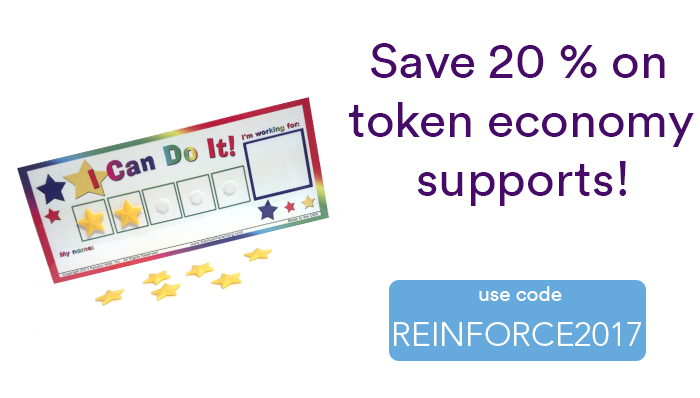This month’s ASAT feature is a review of the Function Wheels, one of our Different Roads exclusives! To learn more about ASAT, please visit their website at www.asatonline.org. You can also sign up for ASAT’s free newsletter, Science in Autism Treatment, and like them on Facebook!
Reviewed by
Jen Cote, BA, Extern
David Celiberti, PhD, BCBA-D
Association for Science in Autism Treatment
Individuals with autism often demonstrate challenging behaviors in home, school, and community settings and, as a result, their service providers develop behavioral interventions to address these challenges. The effectiveness of behavioral interventions is predicated, in part, consistency across people and settings. Aside from inconsistent implementation, one of the primary reasons for the failure of interventions targeting the reduction of challenging behavior is that the intervention does not adequately address the underlying function of the behavior. Behavior intervention plans can be conceptualized in one of three ways:
- Functionally relevant in which the intervention reflects the underlying function of the challenging behavior;
- Functionally irrelevant in which the intervention does not reflect the underlying function of the challenging behavior; or
- Functionally contraindicated in which the intervention includes components that may actually serve to reinforce the challenging behavior (e.g., a time out procedure for a behavior maintained by escape).
Function Wheels is a quick, easy-to-use resource that enables individuals working with students to better understand the underlying function of a student’s behavior and its direct implications for behavioral intervention. Function Wheels is a systematic approach that sequentially guides users through the process of identifying the function of a problem behavior, collecting data on the occurrences of problem behavior, developing a hypothesis based on the pattern of data collected, and implementing research-based interventions for each function. The purpose of the guide is to offer assistance when writing behavior intervention plans, with specific examples laid out in a step-by-step format.
Prior to providing a summary of the contents of this guide, we wanted to share a few cautionary statements with our readers. The Function Wheels is not intended to replace a more in-depth Functional Behavior Assessment (FBA) or Functional Analysis (FA) (Amerson, 2014). According to the author, “While Function Wheels is a handy and useful behavioral tool in the management of behavior, careful considerations should also be given when a more-in-depth and formal FBA or FA is warranted. In such cases, information using Function Wheels can be incorporated into the FBA or FA descriptive information.” (A Guide to Behavioral Interventions, pg. 8). Though this guide provides conceptually systematic interventions, the author further recommends that if a multi-variable treatment package is used, which may be required for certain individuals, multiple treatments should be implemented in consultation with a Board Certified Behavior Analyst (BCBA) or licensed professional who possesses the clinical experience to design, implement, monitor, and/or modify the treatment package accordingly (Amerson, 2014).
As with any tool, the effectiveness is directly connected to the integrity and consistency demonstrated during implementation by the user. For this reason, users must be able to objectively assess their own ability and others’ ability to follow each component of the intervention, and determine if they or the other persons have the skills necessary to effectively implement the intervention techniques. All users should be prepared to seek additional support and training if needed, or request consultation with a Board Certified Behavior Analyst or a licensed professional who possesses the clinical experience to train and support others in the implementation of intervention.
Function Wheels Components
The Function Wheels system consists of separate components, meant to work as a whole, to help teachers proactively identify why problem behavior occurs so they can then follow the research-based interventions and strategies provided. The Function Wheels kit includes:
Guide to Behavioral Interventions:
The Guide to Behavioral Interventions provides research-based interventions and features conceptually systematic interventions that can be adapted and used as a resource to help identify specific management strategies. The first four sections of the guide focus on the four main behavioral functions; behaviors with the function used to obtain attention, behaviors with the function to escape, behaviors with the function to gain access to preferred items, and behaviors maintained by automatic reinforcement. In addition to providing the user with a general knowledge of what the behaviors may look like, the authors also provide examples of how the behaviors may be displayed during specific environmental conditions or situations for different age ranges. When developing a behavior intervention plan, it is critical to match the intervention to the function of the behavior, or reason the behavior is being exhibited. If the function of the behavior is not determined, the intervention implemented could be ineffective or counterproductive.
This guide provides the user with intervention strategies for each function of problem behavior. Each intervention discussed throughout the guide has a brief overview of the history of the intervention and examples of the interventions being implemented. Intervention strategies for the four function areas include, but are not limited to: non-contingent reinforcement/attention, time-out, behavior contract/contingency contracting, reinforcement of successive approximations, contingent sensory access/breaks, sensory extinction, non-contingent reinforcement, and differential reinforcement of other behaviors. Research provided for the interventions ranges from 1969 to 2013. As the author mentioned, this guide is not intended to list all possible interventions, only to provide a sample of interventions available. As research in this field continues to grow, the research basis for the underlying techniques can be expanded upon to reflect the advancements that have been made in the field.
Procedural steps are written out under the intervention. The procedural steps provide the reader with the sequence in which the intervention should be implemented. These procedures include data collection, environmental setup, and reinforcement and consequences dependent on behavioral responses. In addition, the author also includes a Key Notes section, which provides the user with additional knowledge of directions/instructions to be considered when implementing the particular intervention.
User Guide:
The User Guide describes step-by-step how to use the Function Wheels system. Before determining any functions or implementing any interventions, it is essential for the user to feel comfortable with their abilities, and have a solid understanding of all the pieces to this kit. As mentioned previously, it is noted that when looking at the User Guide, the sequence of the steps would lead one to believe that Writing Descriptive Notes (step 5) would take place after the function has been calculated (step 4). In order to determine the function of a behavior, one must fully evaluate the description of the behavior, the antecedent (triggering event) and the consequence (maintaining event). This would be followed by the identification of the function.
Function Wheel:
The Function Wheel is a double-sided wheel featuring eight research-based conditions. One side of the wheel displays antecedent conditions and the other side displays consequent conditions. Turning the wheel allows each user to align an environmental event with the function(s) of the behavior. The smaller, inner wheel represents the presence of a behavior (attention, escape, tangible, automatic), while the larger, outer wheel represents the environmental event, or condition, that triggered and/or maintained the behavior. The function wheel is designed to be a straightforward way of determining the function behind a problem behavior; however, in order to prevent any confusion, it would be helpful to differentiate the side of the wheel designed to help identify the trigger from the side designed to help identify the maintaining event.
Student Screening Sheet:
The Student Screening Sheet provides a template for tracking each incident of the problem behavior. It allows for up to 15 behavioral events to be recorded. Fifteen recordings across at least three observations are recommended to provide an adequate sample to help identify the function of the problem behavior. The Student Screening Sheet has three distinct sections: Description of Observable Behavior, Functional Categories, and Descriptive Notes (detailed information about the antecedent and consequent condition for each observable behavior recorded). Though the Student Screening Sheet offers its user a simplistic way to track data on behavior, the arrangement of the screening tool could mislead one to believe the function of the behavior is determined prior to examining antecedent variables and consequent/maintaining variables. To be clear, the function of a behavior should not be determined prior to the examination of all variables.
Intervention Wheels:
The four Intervention Wheels are Attention, Escape, Tangible, and Automatic. The specific Intervention Wheel directly related to the identified function provides recommended research-based treatments across six intervention areas. In addition to providing the user with research-based treatments across the intervention areas, the authors have placed ‘Facts to Remember’ on the front of each Intervention Wheel. The facts offer broad tips that are beneficial when working with any behavior despite the function, but it may be more beneficial to connect function. Although this guide provides conceptually systematic interventions, the author further recommends that if a multi-variable treatment package is used, which may be required for certain individuals, multiple treatments should be implemented in consultation with a BCBA or licensed professional who possesses the clinical experience to design, implement, monitor, and/or modify the treatment package accordingly (Amerson, 2014).
Utilizing the Function Wheels System
The Function Wheels system can be used two ways: the Function Wheels Brief Method or the Function Wheels Extended Method. Both methods can be utilized by any individual working with students. The Function Wheels Brief Method includes collecting data using the Student Screening Sheet to capture functions of behaviors as they occur, then based on the information obtained, proceeding to the corresponding Intervention Wheel to read about interventions which could minimize the occurrence of problem behavior and reduce any unwanted, inadvertent, or unintentional reinforcement of the problem behavior. A limitation of the Brief Method noted by the author, involves careful consideration of the tentative hypothesis formed about the function as it is not verified prior to intervention when the Brief Method is employed.
The second method, Function Wheels Extended Method, utilizes the same framework but with more detail. Time is taken to meet as a team to define the target behavior and discuss data collection. Following the data collection process, the team meets again to discuss and analyze the variables associated with the unwanted problem behavior, determine the behavior’s function, and what potential interventions can be employed. The difference between the two methods is the time spent collecting data, which during the Extended Method takes place over several sessions or days. This will allow for confirmation or provide the team with an opportunity to test the hypothesis regarding the function(s) of the student’s challenging behavior and more importantly, to engage in a validation process prior to the start of any intervention.
Conclusion
The Function Wheels kit is an easy-to-use resource that provides service providers who have a basic knowledge of learning principles and who appreciate the communicative intent of challenging behavior and its functions with a way to quickly determine appropriate interventions for problem behaviors based on the function of the behavior. For effective implementation of behavior intervention plans, it is essential for the user to have clinical knowledge and experience, or access to working directly with a more qualified professional. A concern with the utilization of this kit with those who are less experienced or knowledgeable would be the counterproductive effects it can have on students who are already struggling. Secondly, the research basis underlying techniques includes many citations from decades ago, which may give the reader the impression that no other research has been published related to that intervention and that the field has not advanced. Nonetheless, the responsible use of the Function Wheels kit may aide in the quick and effective identification of functions and a comprehensive array of interventions that would benefit many students. We applaud the author for compiling this resource in such an innovative and meaningful manner. For more information, please visit the website for Different Roads to Learning.
Citation for this article:
Cote, J., & Celiberti, D. (2016). Review of The Function Wheels. Science in Autism Treatment, 13(4), 34-37.
About The Authors
Jennifer Cote, M.Ed.
Jennifer received an undergraduate degree in Mental Health and Human Services from the University of Maine Augusta in 2010. Working at a residential facility with adolescents diagnosed with autism sparked an interest in this population. In 2011 she switched her field to Special Education and earned her teaching certification, and completed a Master’s Degree through University of Southern Maine in Special Education in 2017. After becoming interested in Applied Behavior Analysis Jennifer is currently working toward completing the requirements to sit for the BCBA exam. She enjoys enjoy working with children and watching them grow and develop. She continues to teach Special Education.
David Celiberti, PhD, BCBA-D
David is the part time Executive Director of ASAT and Past-President, a role he served from 2006 and 2012. He is the Co-Editor of ASAT’s newsletter, Science in Autism Treatment. He received his PhD in clinical psychology from Rutgers University in 1993. Dr. Celiberti has served on a number of advisory boards and special interest groups in the field of autism, applied behavior analysis, and early childhood education, and been an active participant in local fundraising initiatives to support after school programming for economically disadvantaged children. He works in private practice and provides consultation to public and private schools and agencies in underserved areas. He has authored several articles in professional journals and presents frequently at regional, national, and international conferences. In prior positions, Dr. Celiberti taught courses related to applied behavior analysis (ABA) at both the undergraduate and graduate levels, supervised individuals pursuing BCBA certifications, and conducted research in the areas of ABA, family intervention, and autism.

